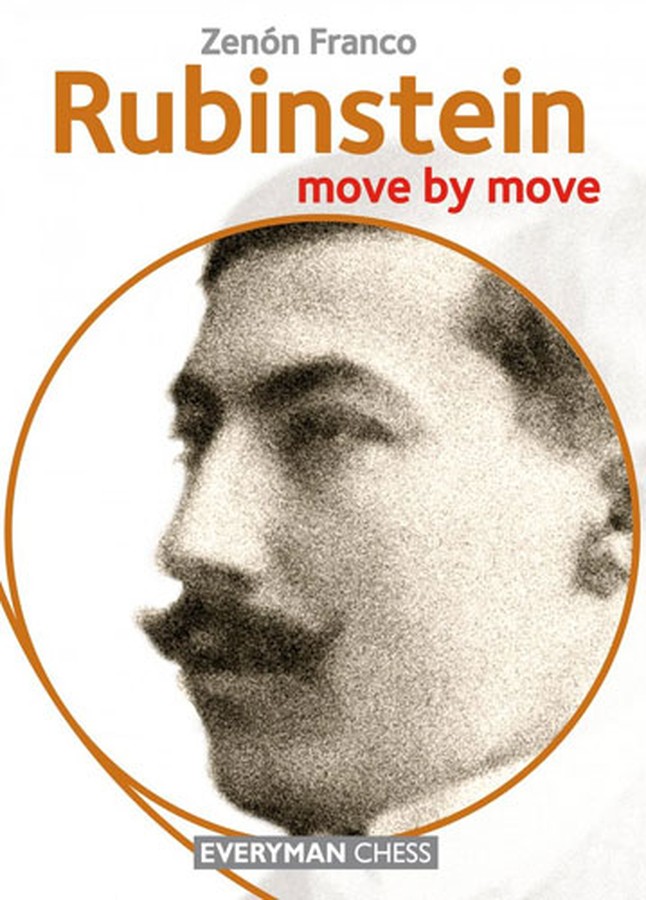| Nivå | B-D |
| Utgivelsesdato | Februar 2016 |
| Forfatter | |
| Pris | 305 NOK |
Rubinstein move by move
Rubinstein var en av tidenes mest elegantspillende. De fineste partiene og sluttspillene hans er legendariske og svært instruktive.
Stormester Zenon Franco viser i denne boka 34 utvalgte partier såpass grundig at boka blir på 400 sider. Nyt og lær!
Forlagets egen omtale
Akiba Rubinstein is a famous figure in the in the history of chess. At his peak, he was arguably the strongest player in the World, and only the outbreak of World War I deprived him of the opportunity to challenge his main rival Emanuel Lasker for the World Championship title.
Rubinstein was an exceptionally talented player whose legacy includes many truly brilliant games. He helped to develop several chess openings and is widely acknowledged to be one of the greatest endgame players of all time.
In this book, Grandmaster Zenón Franco selects and examines his favourite Rubinstein games, and demonstrates how we can all learn and improve our chess by studying Rubinstein’s masterpieces.
Zenón Franco is a Grandmaster from Paraguay, now living in Spain. He represented Paraguay, on top board, in seven Chess Olympiads, and won individual gold medals at Lucerne 1982 and Novi Sad 1990. He’s an experienced trainer and has written numerous books on chess.
De tematiske hovedkapitlene i boka
- Positional Play
- Playing for the Initiative and the Attack
- Endgame Mastery
- Rook Endgames
- Linking the Opening and the Middlegame
Fra forfatterens forord
There are not many books about Akiba Rubinstein, despite his having been for several years one of the best players in the world – and, according to Chessmetrics.com, at various points between 1908 and 1914, even the very best. Rubinstein was certainly among the top five in the world from 1907-16, and even later, but his results then suffered a considerable decline as he had increasing health problems.
Rubinstein is perhaps the strongest player who never managed to become world cham- pion. There are often considered to have been several outstanding players who came close to gaining the world championship, or who deserved to do so. David Bronstein, Paul Keres and Viktor Korchnoi are especially mentioned, and the claims on their behalf are beyond dispute. The difference with Rubinstein is that, while the others were at least able to com- pete for the world title – because a formal procedure for selecting the challenger had by then been established by the international body, FIDE – in Rubinstein’s time this was not the case; he never had the opportunity to play for the title.When I wrote my book on Boris Spassky, I noted that the tenth world champion’s con- tribution to chess literature was remarkably slight. In Rubinstein’s case this is even more extreme: he wrote almost nothing, and when he did write, his commentaries were rela- tively simple, although anything that someone of his strength might have to say is always interesting.
Yuri Razuvaev, the author of one of the few books about Rubinstein, put it this way: “Akiba Rubinstein did not write about himself and about his credo; he has left this oppor- tunity to others, who may judge upon his creative work.”
Some of Rubinstein’s games are very well known, in particular his “Immortal Game” against Rotlewi at Lodz 1907, and his wins against Lasker at St Petersburg 1909 and Capab- lanca at San Sebastian 1911. For anyone not acquainted with these works of art, it will surely be a pleasure to view them for the first time; but even for those who have already seen them, it should still be interesting. These games will generally have been played through “long ago”, and will not be recalled in detail, so looking at them again in greater depth should be a pleasant experience. We don’t need to do quite what Boris Gelfand, one of Rubinstein’s greatest admirers, did regarding Rubinstein-Salwe, Lodz 1908. He said: “This game made a deep impression on me; I played it over many times”.
The task of writing this book, after studying Rubinstein games more deeply, was a very enjoyable one, and I can say that I now appreciate Rubinstein’s marvellous play more fully. I hope I can convey what I felt on looking at his games. In many of them, both in the mid- dlegame and the ending, I seemed to be witnessing a work of art, in which the various parts are united or connected and where, for most of the time, harmony reigns.
| Innbundet? | Nei |
| Type | Bok |
| Språk | Engelsk |
| Antall sider | 400 |
Produktet er en del av serien Move by move partisamlinger
Partisamlingene i denne bokserien blir ekstra godt tilgjengelige for den alminnelige leseren. Forfatterne går grundig gjennom partiene på en verbal måte, med forklarende kommentarer og en dialog med leseren.

